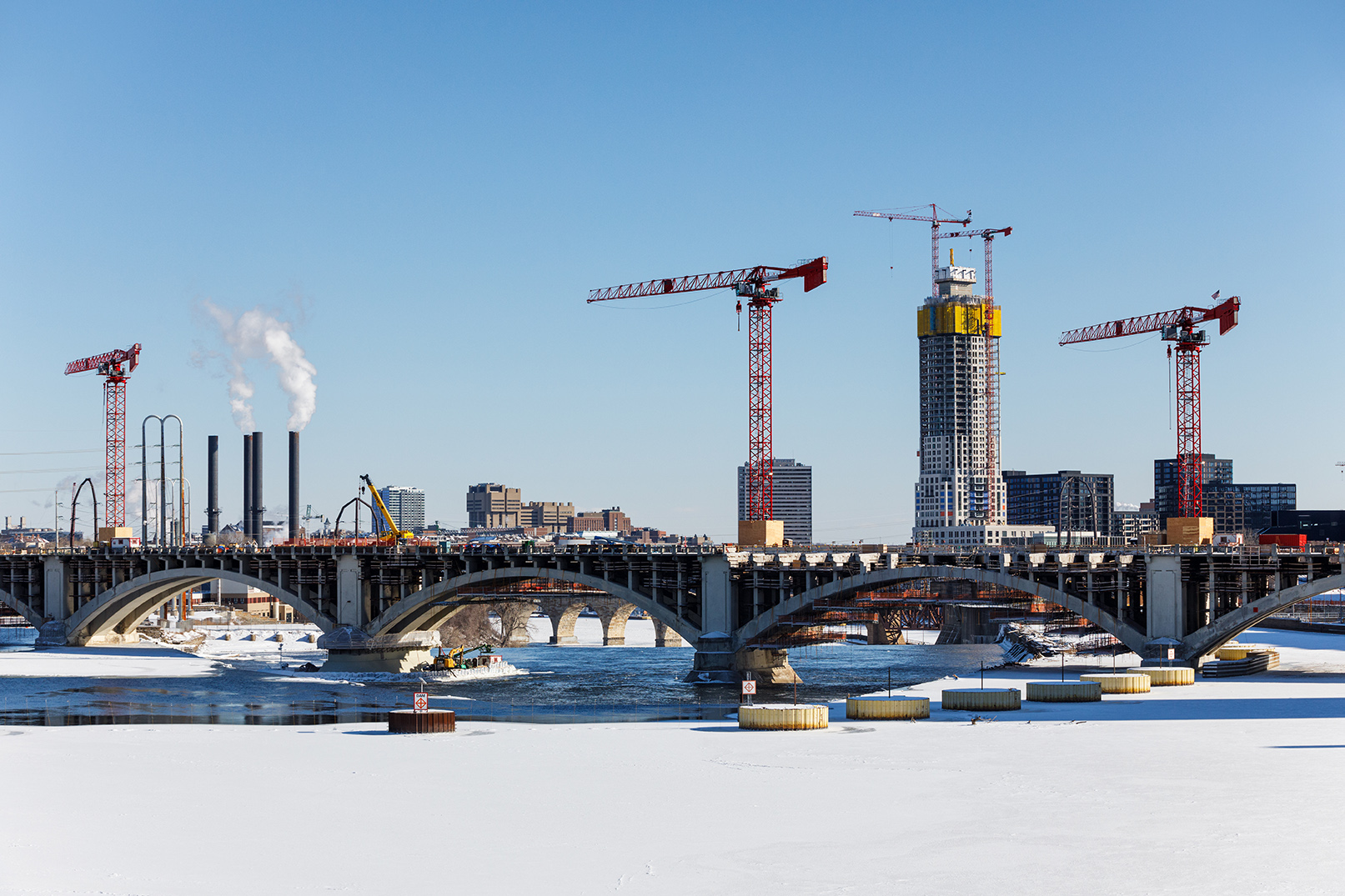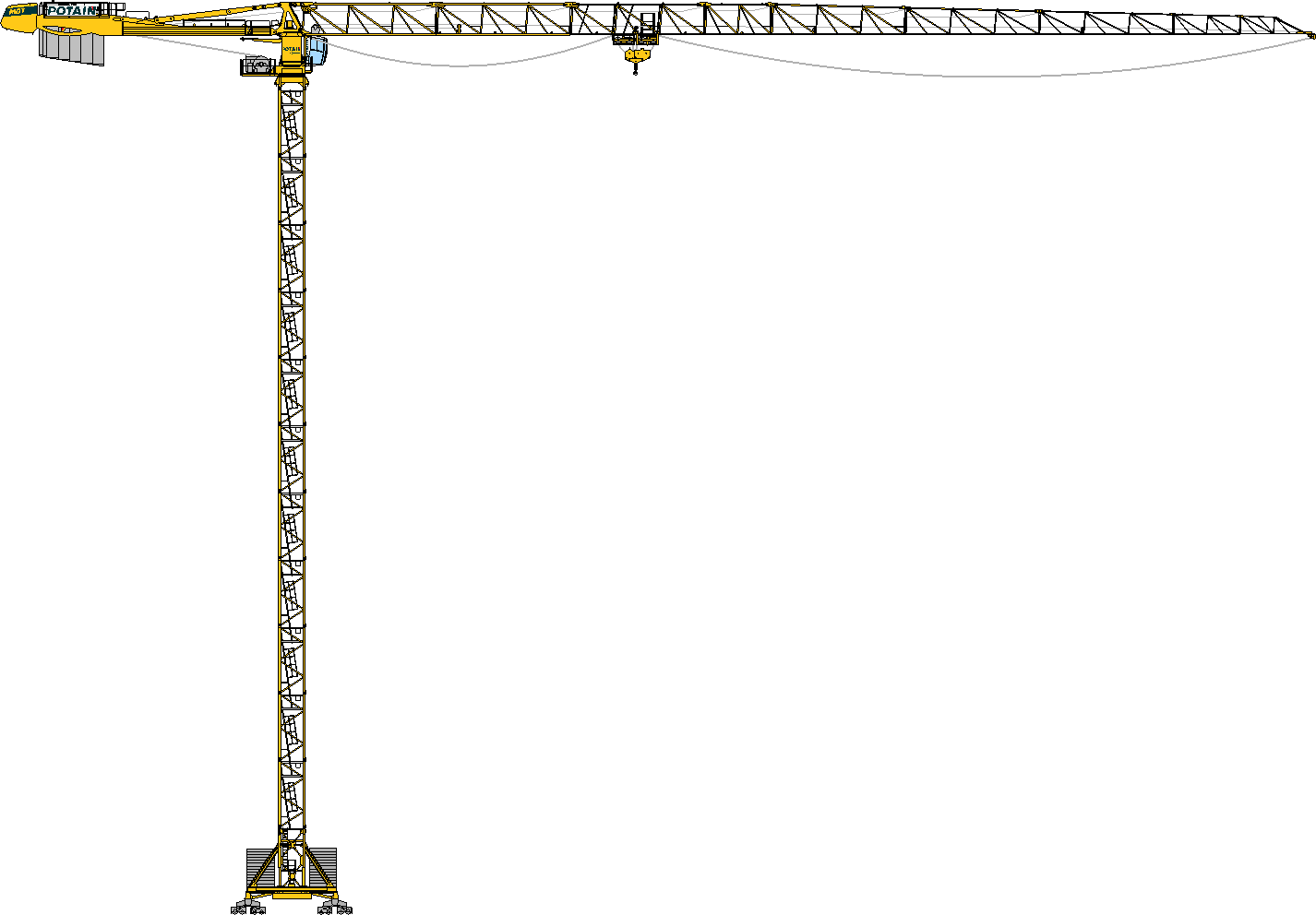
Four Potain MDT tower cranes become integral part of famous Minneapolis bridge’s history — and also its structure
- With conventional crane solutions off the table for a variety of reasons, restoration of the historic Minneapolis Third Avenue bridge called for an innovative new approach.
- Potain MDT topless cranes were built into the piers of the bridge, as traditional anchoring solutions would have required too much space.
- The solution is working so well that the contractors plan to take it into consideration right from the start of future bridge projects — even where more typical solutions would fit.
When a host of awkward access and structural issues meant it would be impossible to adopt traditional go-to lifting solutions for the restoration of the downtown Minneapolis Third Avenue bridge, a handful of Potain topless cranes were the novel answer — and were literally built into its foundations to save the day.
The famous S-curve of this historically important bridge, opened in 1918, was the result of a design decision enforced by difficult foundation conditions resulting from its proximity to St. Anthony Falls spillway — two factors that made the use of tried-and-tested barge crane solutions a non-starter. And because the bridge was built using the old-fashioned Milan arch technique — a steel skeleton clad with concrete arches — the use of standard all-terrain or crawler cranes would have been too risky due to concerns over load-bearing and stress. Finally, the surrounding historic parkland and cobbled streets would have made delivering these cranes with a fleet of large trucks difficult for a variety of reasons.
Fortunately, the great minds at Ames Construction, the bridge project’s general contractor, and FINLEY Engineering Group, Ames’ engineering subcontractor, came up with the bright idea of using Potain tower cranes. But with their typical anchorages being too large for the space available, an even more innovative plan was dreamed up — the existing bridge piers would be used to support each crane.
“We had never tried this before. Pulling it off became very interactive between us, Ames, and our crane supplier, ALL Tower Crane,” said Craig Finley, principal engineer for FINLEY Engineering Group. “We had to find the safest, most effective way to drop the towers into the piers — in other words, embed a section of mast into the box column, then bolt on the rest of the tower crane as normal.”
A new solution
Having calculated that installing a Potain MDT 389 on pier five, plus three Potain MDT 368 tower cranes on piers two through four, would adequately handle the desired loads, the ALL engineers were then able to provide FINLEY with reactions from each crane, maximum allowable movements, and drawings for crane anchor stools.
“Our main point of coordination with the FINLEY team was the interface where the equipment leaves the grillage and becomes the crane,” explained Sam Moyer, general manager of ALL Tower Crane.
Following thorough investigation into how the tower bases could be mounted without damaging the bridge due to the slight deflection of the crane as it handles a load, the column walls were reinforced so as to avoid undue stress on the towers or the pier walls. With a section of deck removed, the hollow portion of the column was opened up down to the footings, where a section of mast was installed before being secured with concrete and rebar.
Then, in January of this year, Dawes Rigging & Crane Rental erected the three MDT 368s, with the MDT 389 joining them in August. As the successor to the MDT 368, this was chosen for use on pier five due to its new, improved Crane Control System (CCS) that ensures securer work around nearby obstructions by virtue of its Top Site geofencing function.
Although both models offer a maximum potential height under hook of over 300 ft, heights from 72 to 120 ft are being employed on this project, due to the horizontal nature of the picks. Likewise, with a maximum possible jib length of 246 ft, the MDT cranes in use in Minneapolis operate configured to avoid overlapping with their neighbors. From their secure, strategic positions, they move a variety of heavy construction materials across the bridge deck, accompanied by a fleet of small Grove rough-terrain cranes that are light enough to avoid causing damage to the deck or bridge structure.
A bridge recreated
“I can’t speak highly enough of the Dawes team that assembled these units,” added Jerry Volz, vice president of bridges and structures for Ames Construction. “Within days, and in the midst of a Minneapolis winter, the cranes were erected and operational.”
Once the Minneapolis Third Avenue bridge renovation is complete and the tower cranes have been disassembled, a portion of each will remain unseen inside the bridge, becoming just another part of its hidden history. And their successful implementation on this project is likely to mean that more tower cranes will be employed as secret weapons in future — even where the traditional choices could be easily adopted.
“We quickly learned to love the towers’ ability to work 180° and out to the midpoint of the span — all of a sudden, it changed the way we looked at towers,” revealed Finley. “This was a first for us, and I’ve been doing this for more than 35 years. In the future, we’ll bring this idea to the table on the first go-round. It’s a good idea that works even better than we could have imagined.”
“This project surely opened our eyes to the fact that Potain tower cranes can be even more advantageous than barge-mounted cranes. It’s something we’ll definitely look at for future projects,” Volz agreed.
CONTACT
Amy Crouse
Manitowoc
T +1 717 593 5960
amy.crouse@manitowoc.com
 Enlarge image
Enlarge image
 Enlarge image
Enlarge image
POTAIN
Top-Slewing Cranes
Top-Slewing cranes are the large construction sites most strategic equipment for productivity. Whether on large infrastructure, high rise jobsites, crowded urban areas or wide open sites, they make it possible to hoist and distribute loads high and far. The Potain brand is a global leader with its multiple ranges of topless cranes, luffing jib cranes and large hammerhead cranes that can also be customized to match special applications.




